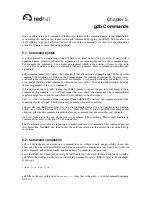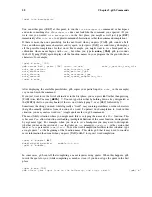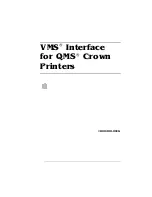
32
Chapter 6. Running Programs Under gdb
1 system thread 27905
0x7b003498 in _brk () \
from /usr/lib/libc.2
thread
threadno
Make thread number
threadno
the current thread. The command argument
threadno
is the
internal gdb thread number, as shown in the first field of the
info threads
display. gdb re-
sponds by displaying the system identifier of the thread you selected, and its current stack frame
summary:
(gdb) thread 2
[Switching to process 35 thread 23]
0x34e5 in sigpause ()
As with the
[New ...]
message, the form of the text after
Switching to
depends on your
system’s conventions for identifying threads.
thread apply [
threadno
] [
all
]
args
The
thread apply
command allows you to apply a command to one or more threads. Spec-
ify the numbers of the threads that you want affected with the command argument
threadno
.
threadno
is the internal gdb thread number, as shown in the first field of the
info threads
display. To apply a command to all threads, use
thread apply all args
.
Whenever gdb stops your program, due to a breakpoint or a signal, it automatically selects the thread
where that breakpoint or signal happened. gdb alerts you to the context switch with a message of the
form
[Switching to
systag
]
to identify the thread.
Refer to Section 7.4
Stopping and starting multi-thread programs
for more information about how
gdb behaves when you stop and start programs with multiple threads.
Refer to Section 7.1.2
Setting watchpoints
, for information about watchpoints in programs with mul-
tiple threads.
6.10. Debugging programs with multiple processes
On most systems, gdb has no special support for debugging programs which create additional pro-
cesses using the
fork
function. When a program forks, gdb will continue to debug the parent process
and the child process will run unimpeded. If you have set a breakpoint in any code which the child
then executes, the child will get a
SIGTRAP
signal which (unless it catches the signal) will cause it to
terminate.
However, if you want to debug the child process there is a workaround which isn’t too painful. Put
a call to
sleep
in the code which the child process executes after the fork. It may be useful to sleep
only if a certain environment variable is set, or a certain file exists, so that the delay need not occur
when you don’t want to run gdb on the child. While the child is sleeping, use the
ps
program to get
its process ID. Then tell gdb (a new invocation of gdb if you are also debugging the parent process)
to attach to the child process (refer to Section 6.7
Debugging an already-running process
). From that
point on you can debug the child process just like any other process which you attached to.
On HP-UX (11.x and later only?), gdb provides support for debugging programs that create additional
processes using the
fork
or
vfork
function.
By default, when a program forks, gdb will continue to debug the parent process and the child process
will run unimpeded.
If you want to follow the child process instead of the parent process, use the command
set
follow-fork-mode
.
Summary of Contents for ENTERPRISE LINUX 3 - SECURITY GUIDE
Page 1: ...Red Hat Enterprise Linux 3 Debugging with gdb ...
Page 12: ...2 Chapter 1 Debugging with gdb ...
Page 28: ...18 Chapter 4 Getting In and Out of gdb ...
Page 34: ...24 Chapter 5 gdb Commands ...
Page 44: ...34 Chapter 6 Running Programs Under gdb ...
Page 68: ...58 Chapter 8 Examining the Stack ...
Page 98: ...88 Chapter 10 Examining Data ...
Page 112: ...102 Chapter 12 Tracepoints ...
Page 118: ...108 Chapter 13 Debugging Programs That Use Overlays ...
Page 138: ...128 Chapter 14 Using gdb with Different Languages ...
Page 144: ...134 Chapter 15 Examining the Symbol Table ...
Page 170: ...160 Chapter 19 Debugging remote programs ...
Page 198: ...188 Chapter 21 Controlling gdb ...
Page 204: ...194 Chapter 22 Canned Sequences of Commands ...
Page 206: ...196 Chapter 23 Command Interpreters ...
Page 216: ...206 Chapter 25 Using gdb under gnu Emacs ...
Page 296: ...286 Chapter 27 gdb Annotations ...
Page 300: ...290 Chapter 28 Reporting Bugs in gdb ...
Page 322: ...312 Chapter 30 Using History Interactively ...
Page 362: ...352 Appendix D gdb Remote Serial Protocol ...
Page 380: ...370 Appendix F GNU GENERAL PUBLIC LICENSE ...
Page 386: ...376 Appendix G GNU Free Documentation License ...
Page 410: ......
















































